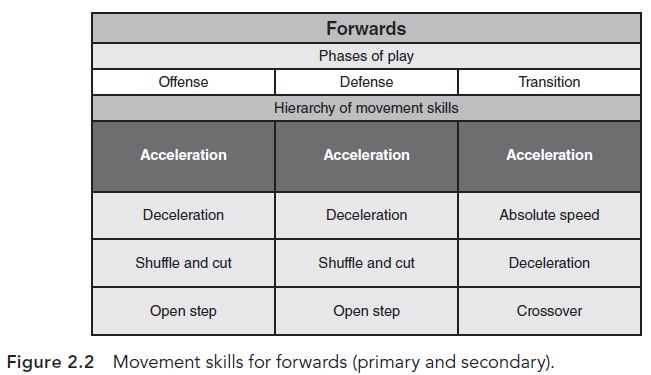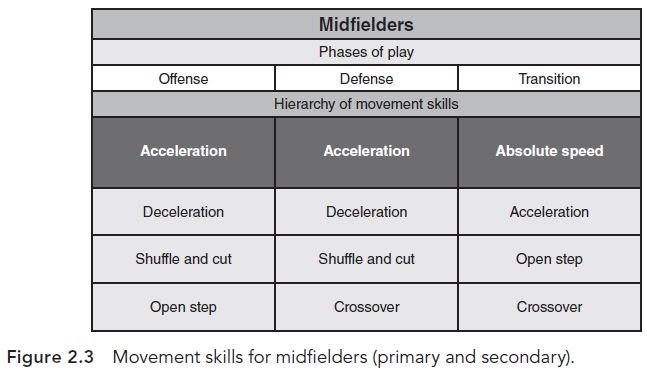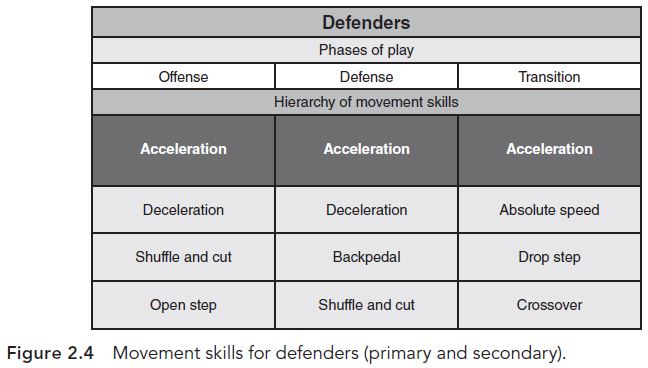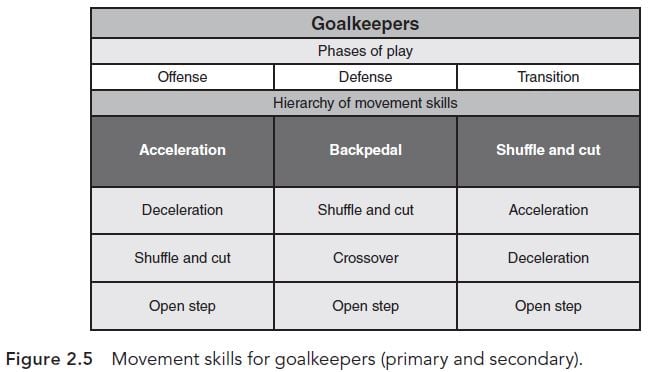Rotational Movement Skills
by Strength Training for Soccer
Kinetic Select
August 2023
The excerpt from Strength Training for Soccer describes the movements necessary for multidirectional speed.
The following is an exclusive excerpt from the book Strength Training for Soccer, published by Human Kinetics. All text and images provided by Human Kinetics.
The structure of multidirectional speed emphasizes linear, lateral, and rotational movement skills. The capability of the soccer athlete to move effectively through movement skills that emphasize the linear or lateral planes of motion are foundational to the game. The more demanding movement skills require the rotational plane of motion.
The rotational movement skills consist of crossover, open step, and drop step. These movements can be completed with the body rotating at various degrees of rotation (e.g., 45, 90, 135, and 180 degrees).
Crossover
The crossover is facilitated by the athlete’s swing leg (i.e., lead leg) coming across the stance leg (i.e., down leg) with minimal to maximal rotation from the upper body, lower body, and hips. The movement skill is typically used when the athlete is facing side-on to the playing situation. The crossover is efficient during times in the match when the distance needed to be covered by the soccer athlete is large, ranging from 20 to 40 yards (18-37 m) and beyond. The movement allows the athlete to be explosive with quality technique in the first few steps and more. During phases of play in transition, the athlete needs to get from one part of the field to another quickly. This has been predetermined by the soccer athlete in the moments leading up to the situation. Longer distances covered by the athlete during the match usually will start with a movement skills sequence of crossover, acceleration, to absolute speed.
Open Step
The open step is executed when the athlete’s swing leg opens up in the opposite direction from the stance leg with minimal rotation or angle. The open step is usually used when the soccer athlete is side-on to the playing situation. The movement skill is mainly used within the game when the distance covered by the athlete is undetermined. For instance, the playing situation is evolving while the athlete is moving. The distance could be shorter (e.g., 2-6 yards [1.8-5.5 m]) or longer (e.g., 10-30 yards [9-27 m]) depending on the soccer environment. A typical observed movement skills sequence is open step, acceleration, to deceleration.
Drop Step
The drop step is accomplished when the athlete’s swing leg opens up in the opposite direction from the stance leg with maximal rotation. The movement skill is displayed when the soccer athlete is facing directly opposite to the playing situation and must turn around rapidly. The drop step allows the athlete to be powerful in one step in a 180-degree movement. Several times during the game, the ball is played over the top and behind the defending athlete (e.g., long ball) while the attacking athlete accelerates through to get to the ball first. The defending athlete must turn around and quickly try to get to the ball before the opponent. Taking one step as opposed to several steps to turn around efficiently can determine the success during this situation in the match. The movement skills sequence might be drop step, acceleration, to absolute speed for the defender. The crossover, open step, and drop step movement skills require the athlete to drop into an appropriate base phase to establish body lean and angles (e.g., feet, knees, and hips) to push through the ground. Depending on the selected movement skill, the athlete will use the foot position (e.g., inside or outside) from the stance leg to produce ground contact force at the proper angles. Training soccer athletes for the physical attributes of a specific position within the game directly relates to multidirectional speed. Each position demands certain multidirectional speed qualities from linear, lateral, and rotational movement skills. In modern soccer, identifying athletes’ physical strength and weaknesses with the physical demands of the game is essential. The sport has progressed to the point where technology can be used to varying degrees to assist in the process. The ability to use match tracking analysis (e.g., Amisco and Prozone) during games is beneficial in examining the differences between athletes, positions, formations, and style of play for the team. Comparing match performance data with athletic performance profiling (i.e., from performance testing) develops an analytics platform for athletes and the position-specific demands for the team. Integrating all of this with GPS tracking systems data from practice on a regular basis develops a performance baseline for each athlete. This allows the analytics to recognize trends and tendencies for the athletes and positions within the team. The culmination of the performance data within a system for the athletes, the positions, and the game establishes a foundation for success. Movement skills and sport skills within soccer are always fused together. The capacity to evaluate, isolate, and integrate allows coaches and strength and conditioning professionals to develop the principles to improve soccer athletes for specific positions in the game.
Forwards, midfielders, defenders, and goalkeepers have different physical demands in the game. All positions require movement skills with and without the ball in possession. The movement skills previously discussed can be adjusted to the appropriate technical skills and tactical skills per position. Figures 2.2 through 2.5 highlight the primary and secondary movement skills for each position. This general summary is a basic review and intended to guide awareness, more than anything, about multidirectional speed qualities. Each soccer athlete uses all the primary movement skills but with a higher or lower priority in context to the specific position.




Strength Training for Soccer will help strength and conditioning coaches create a soccer-specific resistance training program to help athletes at each position—goalkeepers, defenders, midfielders, and forwards—develop strength and power that will prepare them for the demands of a game. The book is available in bookstores everywhere, as well as online at the NSCA Store.
- Privacy Policy
- Your Privacy Choices
- Terms of Use
- Retraction and Correction Policy
- © 2025 National Strength and Conditioning Association